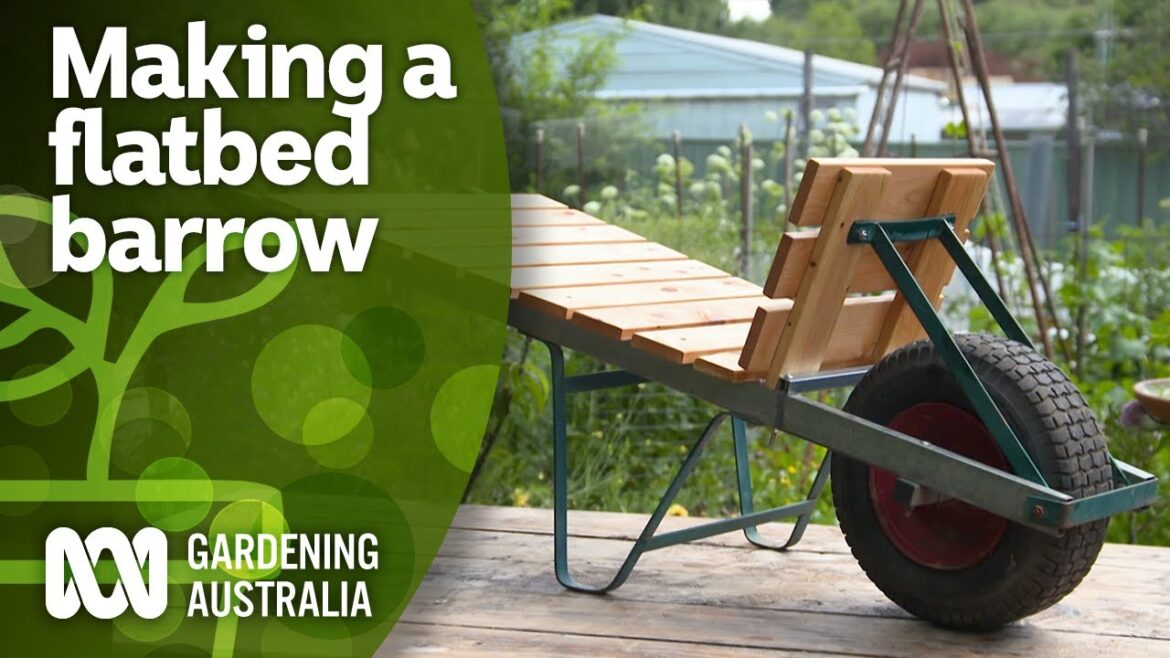Millie shows us how to roll new life into an old wheelbarrow by creating a versatile and useful new tool for the garden, a flatbed barrow. Subscribe 🔔 http://ab.co/GA-subscribe
There aren’t many garden tools more useful than a trusty wheelbarrow. They move mountains of mulch, compost and soil and can be part of our garden journeys for decades. But, when they go from trusty to rusty and the tray is full of holes, don’t throw it out. With some timber, hand tools and elbow grease, it can transform into the perfect tool for moving bales of straw and trays of plants.
Assess and strengthen:
The first step of salvaging anything is to carefully pull it apart and assess what you’re working with. Millie’s barrow has galvanised steel arms and a wide tyre which provides a stable base for a flat-tray barrow. Rusted bolts are replaced with new good quality bolts to secure the structure.
The barrow will form an L-shape like a trolley with a foot at the base near the wheel. The original bucket brace will be the extension of the foot and the weight will be carried mostly by the wheel. To reinforce the foot, Millie secures a second brace of galvanised steel at the base of the platform. It’s a good idea to use the same metal as your barrow to avoid any reactions.
Design and measure:
Measure the span of the barrow and frame to estimate timber for the decking. Millie uses salvaged macrocarpa decking which is lightweight and durable. The pieces are 90mm wide and the length of the platform is approx. 800mm. She has eight pieces for the platform, and five pieces for the foot. This allows enough handle-room for ease of comfort, plus space for the gaps in the decking. The design follows the natural taper of the metal arms, so each length will increase towards the handles. Allow 50mm overhang on each side of the platform to be cut to a taper.
Construction:
Use decking screws designed for steel joists to secure timber to the metal structure. Build the base of the L-foot by notching out two upright pieces of wood to lean snuggly against each brace, then secure. Next, secure lengths to the platform starting near the wheel, smallest to largest, and work your way up. You can use old bolts as spacers between lengths for consistent gaps. Clamp a piece of wood along the edges of the platform as a cutting guideline to cut the excess to a taper. Secure the last three lengths to form the foot, the sand any rough edges and oil to finish.
This flatbed barrow is great for moving straw bales and plant trays which are trickier to move in a bucket barrow, or you can have a sit and plan your next move. Most importantly, it’s made a useful tool out of something that would have been waste, and that’s a great project to involved in!
___________________________________________
Gardening Australia is an ABC TV program providing gardening know-how and inspiration. Presented by Australia’s leading horticultural experts, Gardening Australia is a valuable resource to all gardeners through the television program, the magazine, books, DVDs and extensive online content.
Watch more: http://iview.abc.net.au/programs/gardening-australia
Facebook: http://www.facebook.com/gardeningaustralia
Instagram: http://www.instagram.com/gardeningaustralia
Web: http://www.abc.net.au/gardening
___________________________________________
This is an official Australian Broadcasting Corporation YouTube channel. Contributions may be removed if they violate ABC’s Online Conditions of Use http://www.abc.net.au/conditions.htm (Section 3).


10 Comments
Clever idea 😊💕👍🏽
I like that. But it still falls over. I need training wheels.😊
👍👌🙂
Great idea!! Always good to upcycle.
drilling the slats into the barrow frame was wrong. Two very light weight small rails on the sides connecting the rails could have made the support frame into a removal frame that cold be replaced or cleaned. Just drop it in place.
So love your skills. Great video Thanks.
Great job!
👍
Have I mentioned how much I love Millie?! She always offers up projects that are interesting, innovative, and practical! 💚🧡💛
Really fantastic to see so much done in such a little space. Really takes a lot of the excuses are not to grow your own produce.